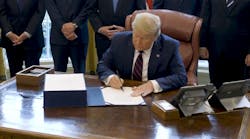OP-ED: Three reasons public transit requires robust investment after historic COVID-19 relief funding
Over the past year, a broad range of industries, highly vulnerable to the consequences of a global public health crisis, were harshly affected by the aftershock of such an unparalleled event. Many of these industries received swift, significant and consistent support from the federal government, including public transit. While public transit was a fortunate recipient of considerable federal funding, it still requires considerable investment in the form of Fiscal Year 2021 appropriations, surface transportation reauthorization and a comprehensive infrastructure package.
The Federal Transit Administration, by way of Congress, will ultimately distribute approximately $69.5 billion in emergency supplemental funding to public transit agencies across the United States. This funding was included throughout three COVID-19 relief bills; the Coronavirus Aid, Relief and Economic Security (CARES) Act provided $25 billion; the Coronavirus Response and Relief Supplemental Appropriations Act (CRRSAA) provided $14 billion; and the American Rescue Plan Act (ARPA) provided $30.5 billion. This funding was and remains critical to ensure the survival of public transit and safeguard a transportation service upon which so many essential workers and small businesses rely.
According to an economic analysis conducted by EBP US, Inc. and issued by the American Public Transportation Association (APTA), “[n]ationally, transit ridership in 2020 dropped by 79 percent compared to 2019 levels at the start of the pandemic.” Though the loss in ridership and resulting fare revenue is hard enough, the situation is exacerbated by ongoing losses in tax revenue and decreases in state funding.
While there are various justifications for further robust investment in our nation’s public transit systems, three stand out as top motivations for the federal government’s continued partnership; the pervasive State of Good Repair backlog, the unknown restoration of ridership levels and future service expansion to ensure sufficient, accessible and reliable service throughout the community and region.
State of Good Repair backlog
According to the American Society of Civil Engineers’ (ASCE) 2021 Report Card for America’s Infrastructure, public transit received a disappointing D-, with a $176 billion State of Good Repair backlog, anticipated to grow to more than $250 billion by 2029. If this is not addressed, ASCE reports that it will “increase congestion, hamper the economy and worsen air quality in the coming years.” Decreasing or eliminating this backlog does not only benefit the reliability and efficiency of the vehicles and service but ensures the transit employees and riding public remains safe – thereby, improving mobility, reducing congestion and encouraging economic development.
Unknown ridership levels
The Federal Transit Administration’s National Transit Database reports that, while “total transit ridership across all modes decreased [from 2010-2019],” passenger miles traveled increased, with commuter and light rail producing a commendable 17.9 percent and 12.8 percent increase respectively. According to the APTA Ridership Transit Dashboard, there was a slight increase in nationwide weekly ridership over the past 13 weeks – perhaps attributable to the rise in COVID-19 vaccinations. While, conceivably, ridership is trending in an upward direction, it is unknown when it might return to pre-pandemic levels or above.
Public transit, like hotels and live entertainment venues, will probably face a protracted recovery from the pandemic. Though transit agencies are deploying all safety protocols and marketing approaches necessary, there is no certainty as to when ridership will return. This will continue to devastate farebox revenue collection rates – for context, farebox recovery in 2019 was 50.5 percent for commuter rail, 49.1 percent for commuter bus, 28.1 percent for bus rapid transit and 22.2 percent for light rail.
Ridership levels alone should not be the determining factor for whether the federal government provides robust investment in public transit. If it were, this past year would have been the end of the industry – but we know other factors influence ridership and the essential service public transit provides warrants continued support.
Future system
The future is bright for public transit, considering the new and emerging transit and mobility technologies, expansion of light rail and bus rapid transit lines through new or underserved communities and the enhancements being made to existing services and related infrastructure. Continued increased investments in federal formula and discretionary programs will improve and support these necessary developments.
Though the answers to significant questions remain outstanding, such as how demographics, economics, technology and politics will shape the future of transit, one certainty remains – it’s needed. Investing in public transit means investing in the communities it serves – for every $1 communities invest in public transportation, it generates approximately $5 in economic returns. Furthermore, a strong public transit industry results in an equally strong private sector. According to a recent poll, 42 percent of APTA businesses members deferred investments in their company because of the pandemic’s impact to public transit and without the ARPA funding, would have cut back hiring, laid off or furloughed employees or had to close facilities entirely.
The future we want to create for our cities, small urban areas and communities across the country require substantial investment from all levels of government. These investments will produce a transit system that enhances system safety and reliability, addresses the climate crisis, increases jobs and encourages workforce development and ensures a more equitable transit network.
The current decrease in transit service and ridership is temporary, and the reduced transit service levels are not reflective of the true transit needs in our communities. Congress’ prioritization of public transit should reflect that of the public’s, and with more than 70 percent of all transit-related ballot initiatives approved since 2017 (90 percent approved in 2020), the industry is clearly favored by communities across the country.
------

Bennett E. Resnik | Bennett Resnik, Senior Vice President, Venn Strategies
Bennett E. Resnik is a senior vice president in the Critical Infrastructure Practice at Venn Strategies, a full-service government relations and public affairs firm. Advocating before Congress and Federal agencies, Bennett advises clients on proposed federal regulations, federal funding and political strategy, advocating for favorable legislation and sensible regulations in the transportation and energy sectors.







